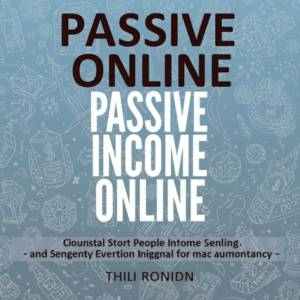Understanding Passive Income
Passive income refers to earning money with little to no ongoing effort once the initial setup is complete. It differs from traditional active income, where you trade your time for wages or a salary. Instead, passive income typically involves creating or investing in assets that generate revenue over time. These assets can take various forms, such as intellectual property, financial investments, or automated systems.

What makes passive income appealing is its potential to create financial stability while freeing up your time for other priorities. While it often requires significant effort upfront—whether developing a product, building a platform, or conducting thorough research—its ability to deliver consistent returns makes it an attractive option for many. Passive income opportunities exist in a wide range of industries, allowing individuals with different skills and interests to explore what works best for them.
Popular Ways to Earn Online
Exploring different methods to earn online can lead to consistent passive income opportunities. Among these, affiliate marketing is a standout option. This approach allows you to partner with companies or brands by promoting their products or services. When someone makes a purchase using your referral link, you earn a commission. To succeed, you’ll need to choose products that align with your audience’s interests and strategically place links in your content, whether that’s on a blog, a social media account, or a YouTube channel.
Another profitable route involves creating and selling digital products. These products include templates, design files, eBooks, or courses that you develop once and sell repeatedly. For example, an online course can teach a skill or provide solutions to specific problems. Platforms like Etsy, Gumroad, and Teachable make it easy to host and sell digital content. Once your product is live, sales can occur without any additional input, making this method a favorite for those seeking hands-off earnings.
Online platforms have also opened the door to earning through print-on-demand services. By designing custom graphics or artwork, you can upload your creations to services like Redbubble or Printful. These platforms handle the production, shipping, and customer service, leaving you with a percentage of the profits for every item sold. This method requires minimal upfront investment and can be an excellent option for creative individuals.

Additionally, licensing content you’ve created can generate royalties over time. For example, photographers can sell stock images on websites like Shutterstock, while musicians can license their music for use in advertisements, films, or other media projects. Each time your content is used or purchased, you earn a royalty fee, providing a steady income stream for as long as the content remains in demand.
Subscription models are another way to monetize your online work. Whether through Patreon, Substack, or similar platforms, you can offer exclusive content to paying subscribers. This could include bonus materials, early access to content, or members-only discussions, allowing you to build a reliable income stream while strengthening connections with your audience.
Investing for Passive Returns
Investing is one of the most effective ways to build passive income over time. A popular choice for many is dividend-paying stocks. These stocks belong to companies that distribute a portion of their profits to shareholders, providing consistent payouts. Dividends can be reinvested to purchase more shares, further compounding your earnings and growing your investment portfolio.
Real estate is another promising option, and thanks to advancements in technology, getting started is easier than ever. Real estate investment trusts (REITs) allow you to invest in property markets without owning physical property. These trusts pool money from multiple investors to fund income-generating real estate ventures. You receive a share of the profits, typically through dividends, without dealing with property management responsibilities

.
For those interested in diversifying their investments, peer-to-peer (P2P) lending is an alternative to consider. Through platforms like LendingClub or Prosper, you can lend money directly to individuals or small businesses in exchange for interest payments. This method allows you to spread your investment across multiple loans, reducing overall risk.
Another way to earn is by investing in index funds or exchange-traded funds (ETFs). These funds track the performance of a specific market index and are managed to ensure steady, long-term growth. With low fees and broad diversification, they are a solid option for those new to investing or looking for hands-off management.
Cryptocurrency staking is gaining traction as a more modern approach to earning returns. By locking up a specific amount of cryptocurrency in a wallet, you help secure the network and, in return, earn rewards. While it can be more volatile than traditional investments, staking can generate returns if approached with caution and proper research.
For those seeking more direct control, acquiring fractional ownership in businesses through crowdfunding platforms is a viable path. By investing in startup ventures or small companies, you can earn equity or profit shares. Although this approach carries higher risks, it also comes with the potential for significant financial rewards if the business succeeds.
Investing for passive income does require research, patience, and a solid understanding of the risks involved. Exploring these options can open up new opportunities to grow wealth while minimizing hands-on involvement.
Creating Online Content
Building an online presence through content creation offers a unique way to establish income that grows over time. With platforms like blogs, YouTube, or even podcasts, you can tap into a global audience and share your expertise, interests, or experiences. The foundation of successful online content lies in understanding your niche and audience, allowing you to tailor your material to their needs and preferences.
Once your content starts gaining traction, there are several ways to generate income. Ad revenue is one of the most accessible options, particularly for YouTube creators who can enable monetization through ads displayed on their videos. Sponsored content is another lucrative avenue, where brands pay you to feature or promote their products within your content. To attract sponsorships, you’ll need to focus on creating high-quality, consistent material that demonstrates value to your followers.
Another income-generating method involves offering premium content behind paywalls. Platforms like Patreon or Substack allow you to provide exclusive videos, articles, or other materials to subscribers who pay a monthly fee. This approach works especially well if you’ve built a loyal audience interested in deeper engagement or additional value.

For those with a creative flair, designing and selling branded merchandise can also tie into your content strategy. Custom T-shirts, mugs, or posters featuring your logo or slogans not only provide an additional income source but also strengthen your brand identity. Many creators partner with print-on-demand services, which take care of production and fulfillment, requiring minimal effort on your part.
Repurposing existing content is a highly effective strategy to maximize your reach and earnings. For example, you can turn blog posts into short videos or social media posts, giving your work a second life across various platforms. This ensures your content stays relevant while reaching different audience segments.
Affiliate marketing also plays a significant role for content creators. By recommending products or services aligned with your niche and sharing affiliate links, you can earn a commission for each sale generated through your referrals. This approach works seamlessly with blog posts, tutorial videos, or product reviews.
Lastly, consistency is key when establishing yourself in the digital content space. Regular uploads or posts build trust with your audience and encourage return visits, creating a stable foundation for future income opportunities.
Automating Your Income Streams
Automation plays a crucial role in optimizing passive income strategies, making it possible to save time while increasing efficiency. A key area where automation excels is in managing repetitive tasks, such as handling customer inquiries, updating inventory, or processing payments. With the help of tools like chatbots or customer relationship management (CRM) software, you can streamline these processes, allowing your focus to remain on strategic growth.

Content scheduling tools are another invaluable resource for automating income streams. Platforms like Hootsuite or Buffer enable you to schedule posts across multiple social media channels, ensuring your online presence remains consistent without daily effort. Similarly, YouTube creators or bloggers can schedule their content in advance, keeping their audience engaged even during periods of downtime.
For those involved in affiliate marketing or selling digital products, integrating payment gateways and email marketing platforms can be transformative. Services like PayPal, Stripe, or ConvertKit automate payment processing and order confirmations while also managing follow-up communications. By setting up automated email sequences, you can nurture relationships with potential buyers, recommend related products, or share useful updates that drive further engagement.
E-commerce platforms offer a range of automation options, from inventory management to automated shipping. Tools like Shopify and WooCommerce simplify processes like order tracking and stock updates, reducing the need for manual oversight. Print-on-demand services take this concept further by automating production and fulfillment, leaving you free to focus on designing new products or marketing your brand.
For those investing in financial assets, automation tools like robo-advisors can assist in managing portfolios, rebalancing investments, and reinvesting dividends. These tools minimize the time and expertise needed to maintain a diversified portfolio while ensuring alignment with your financial goals. Automated contributions to retirement accounts or savings plans are also effective for building wealth steadily over time.
Additionally, project management software like Asana or Trello can help coordinate outsourced tasks and track progress, ensuring your overall business operations run smoothly. Whether working with freelancers, graphic designers, or content writers, these platforms help keep everything organized without requiring constant oversight.
Automation not only saves time but also reduces the likelihood of errors, ensuring your operations run more smoothly. Embracing the right tools and systems can make scaling your passive income much more attainable. Investing in the right software and taking advantage of automation options enables you to spend less time on routine tasks and more time on growing your ventures.
Managing and Growing Your Earnings
To effectively manage and grow your passive income, it’s important to adopt a proactive approach. Start by setting clear financial goals and determining how your income streams align with these objectives. This allows you to prioritize efforts that deliver the most value while minimizing wasted time and resources.
One key strategy is to diversify your income sources. Relying on a single stream can be risky, as market changes or unforeseen circumstances may impact its stability. By exploring additional opportunities, such as new investment options or complementary revenue channels, you can create a more resilient financial foundation.
Another critical step is maintaining a budget for your ventures. Regularly assessing your expenses ensures you’re allocating funds efficiently, whether for marketing, platform fees, or product development. Keeping your costs in check helps maximize profitability over time.
Leveraging analytics tools is also beneficial for tracking progress. Platforms like Google Analytics or social media insights can provide valuable data on audience behavior, helping you refine your strategies to better meet demand. Similarly, financial tracking tools allow you to monitor revenue and identify patterns or trends that can inform future decisions.

Improving efficiency is another area to focus on as your income grows. Consider outsourcing tasks or investing in tools that save time and streamline operations. This could include hiring virtual assistants for administrative work or using software to automate processes like email campaigns or content scheduling.
Additionally, staying informed about industry trends is essential for staying competitive. Passive income strategies often evolve alongside technology and consumer preferences. Regularly researching updates and exploring innovative tools or platforms can help you stay ahead of the curve and identify new opportunities.
Finally, reinvesting a portion of your earnings back into your ventures is key to sustainable growth. Whether it’s upgrading your equipment, expanding your portfolio, or increasing your marketing budget, reinvestment allows you to scale your efforts and potentially unlock higher returns.
By combining careful planning, diversification, and ongoing optimization, you can strengthen your passive income streams and ensure they continue to grow over time.see more


